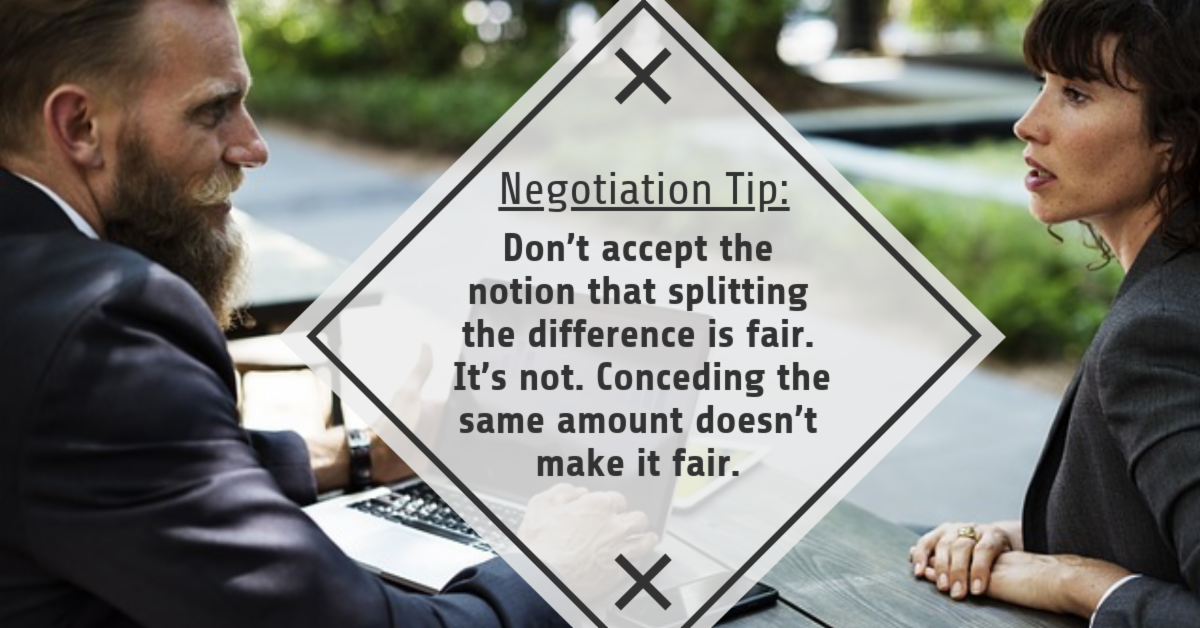“Let’s just split the difference,” he suggested after we had negotiated all day over my client’s lawsuit. Our last offer? $320,000. His last? $300,000.
Sounds fair, right? Almost everyone has used this closing technique when negotiations drag on. After all, splitting the difference means both parties compromise and give an equal amount. What’s wrong with that?
The following response in the above negotiation illustrates its problems. “Let’s see,” I said. “You’re saying you’ll come up to $310,000, right?” “Right,” he responded. “But only if you come down to $310,000.”
“Tell you what I’ll do,” I said. “I’ll take your $310,000 offer to my client and see what he says, OK?” “Uh, OK,” he responded.
What just happened? My counterpart’s “split the difference” offer just turned into a $10,000 concession. He’s now mentally and orally committed to $310,000, and we’re still at $320,000. We have yet to concede a dime.
I then spoke to my client and returned.
“My client wanted to stick at $320,000,” I said, “but I convinced him that would lead to an impasse. He ultimately agreed to $315,000.” I then said how it would be a shame to leave, after negotiating all day, with only $5,000 separating us.
My counterpart then offered to split the difference again, and we settled at $312,500. This negotiation illustrates the problems with offering to split the difference.

First, the party making the offer often loses proportionately more at the end. In the above case, my client – the recipient of the offer – ended up with $2,500 more than the “split the difference” amount at $310,000.
This resulted from a tactic called bracketing. In bracketing, the party responding to a first offer selects an initial counteroffer such that their desired goal ends up halfway between the parties’ offers.
If you offer $200 for my skis and I want to sell them for $250, I’ll “bracket” your offer by countering at $300. It then appears more natural and fair to end up at $250.
In splitting the difference, if you offer to split it, you’re effectively making a first offer. In doing so, you’re giving the other side the opportunity to re-bracket your offer to their benefit. Each time the other side does this, and you concede by less than the “split the difference” amount, you benefit more proportionately.
Second, the recipient of the offer always benefits from a psychological standpoint. In most cases, you want the other side to walk away thinking they won or, at least, feeling they got a fair result.
When that happens, you can almost always preserve the relationship – an important element in most negotiations. When you’re the recipient of a split offer and you accept it or make a last concession, it’s likely the other side will feel they “convinced” you to make that concession. This is psychologically important.
So what should you do regarding “splitting the difference?”
- Don’t offer to split the difference. Get the other side to suggest it. You can oftentimes prompt a “split the difference” offer – near the end of negotiations – by lamenting the small amount between the parties’ offers and the significant time everyone has spent negotiating.
- Don’t accept the notion that splitting the difference is fair. It’s not. Conceding the same amount doesn’t make it fair. Fairness largely depends on the standards or principled basis underlying your offer or concession.
- If you’re selling a used car for its “Blue Book” value of $15,000, and a potential buyer offers $10,000, splitting the difference at $12,500 makes no sense. The “Blue Book” value reflects an objective basis for your car’s market value. Splitting the difference means, in that context, simply giving up $2,500.
- Beware of bracketing and center movers. In our culture, many negotiators – I call them Center Movers – inevitably move toward the center of both parties’ starting points. Remember this, and make your offers and concessions accordingly.
Of course, you might argue that the amounts at issue near the end of many negotiations don’t make a big difference. That may be true. On the other hand, that attitude will cost you.
Previously published in The Phoenix Business Journal

